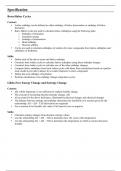Summary
Summary AQA A Level Chemistry - Unit 3.1.8: Thermodynamics - Full Notes
- Institution
- AQA
Detailed and comprehensive notes on unit 3.1.8 (thermodynamics) for AQA A level chemistry. Covers: enthalpy change definitions, born haber cycles, the perfect ionic model, entropy, Gibb’s free energy, enthalpies of solution and feasibility.
[Show more]



